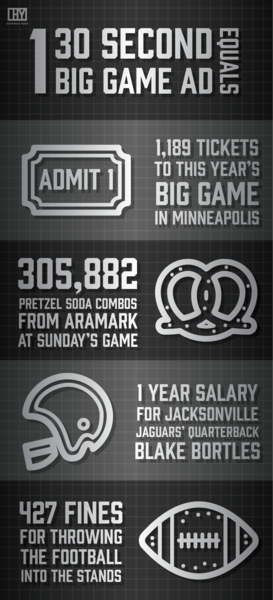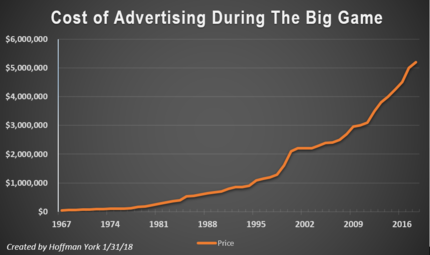

IS ADVERTISING DURING “THE BIG GAME” WORTH IT?
In 1967, the price tag on a TV spot during Pro Football’s grand finale event was a modest $40,000 (around $294,000 with today’s inflation). In 2018, a 30-second TV spot during The Big Game will run brands about $5.2 million, that’s $166,667 per second! Sure that’s a lot of money, but let’s consider what’s at stake.
In the time of cord-cutters and DVRs, it is one of a handful of events that is watched live with the inability to skip commercials. But honestly, who would want to skip the commercials? Research shows that 97% of viewers enjoy the ads. During typical television viewing, commercials are occasionally ignored by running to the bathroom, grabbing a beer, or preparing a snack. Not here. During this game we shush our friends as the ads roll, saving bathroom breaks for halftime. We have the viewers, we have their attention, but who has the checkbook? As the price continues to climb, we ask: Is advertising during The Big Game worth it? To answer that, the creative and media experts at Hoffman York weighed the pros, cons and potential ROI for brands willing to go big or go home. Here are 10 factors to consider before budgeting for next year’s Big Game.
1. Are you a new brand or do you have a new product?
The greatest takeaway of running an ad during The Big Game is brand awareness. For small or new brands the $5.2 million price tag can be a turn-off but the right ad lives past that 30-second spot. Anything “new” will get people buzzing, be that a new idea, a new flavor or a new design. Commercials have the ability to become viral videos on YouTube and social media based on the “you’ve-gotta-see-this-ad” factor. Seriously, would anyone know what Go Daddy is without their TV spots during The Big Game?
2. Have you advertised during the game consistently in the past?

For some brands, the game has always been a part of the marketing strategy. Because of this annual repetition, consumers have grown to expect ads from these key players. Viewers are waiting for Avocados from Mexico just as they were anticipating the E-Trade Baby post-2008.These brands have already developed “top-of-mind” names. An annual spot may not cause a dramatic spike in sales, but it can help maintain high levels of brand awareness.
3. Is the creative entertaining and memorable?
February 4th will be the first day in 2018 when viewers want to watch commercials. Many brands gravitate to humor which, for some, works well. Some make us laugh while others like Budweiser’s Puppy Love ads make us cry. But bear in mind, the stakes are high for developing a spot that will move people—to laughter or tears. If you’re going to spend “Super” dollars, make them count. And by all means, don’t waste 30 seconds and $5.2 million to show viewers the same creative that’s been airing for the past six weeks.
4. Are you willing to put in the maximum effort?
There’s publicity, social buzz, not to mention more than 100 million viewers. No pressure. These viewers immediately turn to social media to share their thoughts on the ads they liked (and disliked), so you need to be ready to manage comments and questions—good and bad. A great TV spot can also lead a wave of traffic to your website all at once, so ensure it doesn’t crash. Lumber 84 created a controversial 90-second ad that aired during last year’s game. This spot cost the company 70% of its annual advertising budget alone. The massive response on its website had it crash in seconds. The issue was resolved in 10 minutes, but how many users were already onto the next ad? The Big Game is the biggest advertising day of the year, make sure your team and techs are ready.
5. Does your ad have anything to do with your brand?
TV ads are essentially little salespeople we pay to go to the homes of our prospective customers and make a pitch. If we just wanted to tell them a random funny story, we could mail them a book. Make sure your ads aren’t just telling a story, make sure they are telling your story. Audi’s example on equal pay from last year’s reel shows a great story with a weak tie-in.
6. Does your ad rely heavily on audio?
When it comes to The Big Game, half of all Americans plan to either host a party, attend one or watch the game at a local restaurant or bar. This according to Statista. That means 50 million people will be watching it in a noisy environment. Hearing the audio of the game itself isn’t entirely instrumental to knowing what is happening, and ads should follow this standard. If your story can’t be deciphered through visuals alone, the viewers in bars and restaurants may not receive the message.
7. Are you putting all your eggs in one Super basket?
A drop in the bucket for some brands, and entire budget for others. If a brand wants to advertise on Super Sunday, there are a few ways around that $5.2 million budget. A 15-second ad will cost a mere $2.6 million. In 2017, 15% of all TV spots were 15 seconds as compared to zero just 14 years prior. A good example is Wonderful Pistachio’s 15-second spot from last year. In addition to being less expensive, these shorter spots align with the shorter attention span of many of today’s viewers. In fact, the average attention span for millennials is 5 to 6 seconds when viewing an ad. If that’s still too costly, there’s the option to advertise through a local network affiliate during The Big Game. A handful of local spots will air before and after halftime and then between the third and fourth quarters. The cost of a local spot is dependent on the estimated amount of local viewers and the network. Lastly, brands may consider advertising during other Super Sunday events like The Puppy Bowl or even buy space immediately after the game, a stunt that netted Esurance plenty of buzz and rave reviews four years ago.
8. Is your topic too controversial?
Sure, when done right, brands can strengthen relationships with viewers by taking a stance on political issues. While you are strengthening relations with one side, the brand can often alienate the other. The Big Game is about fun, entertainment and having a good time. Try and keep partisan issues out in order to appeal to the greatest number of viewers. If an ad is too controversial, it can even be rejected by the network like this years’ AMVETS spot.
9. Does your brand match the game’s audience?
This is a time for fun, lightheartedness. Therefore, the brands that often see success advertising during The Big Game are those that appeal to this fun-loving crowd. Save darker, more complex products for a less entertainment-demanding (and less expensive) program slot.
10. How does the cost of one spot compare to other television advertising?

According to our media buying experts, the estimated reach for one TV spot in 2018’s game is 45% of all households. To match this, you would have to buy 10 to 15 spots of Primetime television nationwide. While the cost to do so is about half what a 30-second spot during The Big Game costs, you give up the buzz, undivided attention and mystique that comes with being part of it. A good spot is watched millions of times online, with the best one of the year featured in specials highlighting great TV ads for years to come. If you’re confident in your creative, there’s really no comparison. Why kick a field goal when you can score a touchdown?
Which ads were worth the price of admission for this year’s Big Game? Check back next week on the HY News page for Hoffman York’s break down of this year’s winners and losers.
For more HY news, click here!